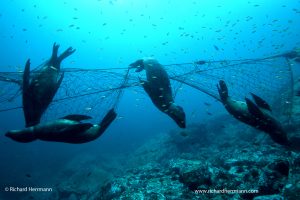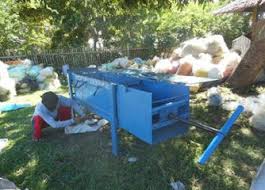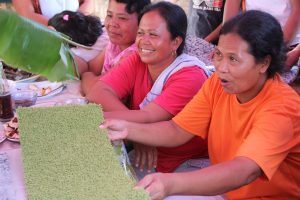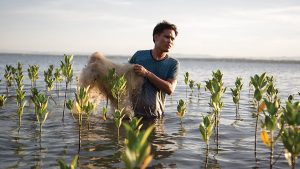The Killer Ghost of the Seas
Ghost fishing is a global problem with too few solutions. It occurs when fishing nets are lost or abandoned at sea, and continue to fish unintentionally with no one to reap what is sowed. An estimated 640,000 tonnes of ghost gear is lost yearly around the world. Fishing nets can take 600 years to break down, leading to an accumulation of vast environmental harm, including extremely wasteful death of marine mammals and suffocation of coral reefs. New initiatives have sprung up to combat this problem, one of which being the Net-Works project. Communicating with the parties involved in Net-Works and developing a clearer understanding of the overall process painted a picture where direct marine impacts may come off as more significant than in actuality, but other benefits to the participating communities are clear.

The Net-Works Project
Net-Works is an innovative net recycling program founded in 2012 as a collaboration between Interface Inc., Zoological Society of London (ZSL), and Aquafil Group. Interface Inc. is the largest worldwide producer of carpet tile. Their role in Net-Works is to manage the business side of the operations: to provide business strategy, start-up capital and access to a global network. ZSL is an international scientific, conservation and educational charity and is actively involved in conservation projects in over 50 countries. ZSL’s role in Net-Works is to provide the conservation expertise, community organisation and local partner development. Aquafil Group uses innovative technology to recycle the nylon nets into yarn. Net-Work’s aim is to build a new model of conservation management driven by the community to break the cycle of donor dependency [1].
Net-Works was founded by Miriam Turner, the Assistant Vice President of Co-Innovation for Interface Inc. who had a love for and background in ecology. She initiated the discussion between interested parties and eventually looped in Dr. Nicholas Hill from ZSL, who was key in setting up locations for Net-Works [2].
Where Is It?
Net-Works has 35 communities participating in the Philippines and Cameroon. These communities are rural, coastal and lakeside where fishing is often the only source of income and are completely dependent on the ocean for their needs [1]. Nylon net waste is thereby a major problem because it pollutes the ocean and affects their main and oftentimes only livelihood by harming fish stocks and fishing equipment. These are also communities where financial infrastructure is sorely lacking and needed [1].

How Net-Works Works
Net-Works has been noted due to its innovative model that synergises business and conservation organisations, and coastal communities. The installation of a Net-Works’ site is initially managed by ZSL, until community members are trained and can run the process independently. Using funding from Interface, ZSL begins with setting up community banks and building partnerships with local organisations. Training is provided by ZSL to identify specifically Nylon 6 nets, the only type of net that is recyclable through Net-Works [3]. Once trained, the community banks and local organisations collect nets once a week. These nets are then cleaned, sorted, and compacted using baler machines provided by ZSL [3,4]. Net-Works buys nets from locals through the banks and organisations and ships the nets to Aquafil. Shipping costs are covered by Aquafil and the reprocessed fibre is sold to Interface, to be used in carpet tile production [5,6].

What Net-Works Has Done for Communities

Net-Works is centered around community banks which provide financial management to locals. The Net-Works project is implemented through these banks and existing microfinance institutions such as the Negros Women for Tomorrow Foundation. These associations empower individuals through access to loans for starting new businesses such as seaweed farms. The generation of profit for all parties is what enables this project to thrive. Although the direct marine impacts of the project are not well scoped out, there are positive environmental impacts that have already appeared. Communities have started to increase their value of environmental sustainability, as evident by the creation of locally driven conservation initiatives.
“I am very happy and very punctual. I use this as an opportunity to meet others and find out more about the community and what’s happening. On the rare occasions that I cannot attend, I am committed to paying my fines to the community bank, as this is my responsibility.” – Nonilon, age 63, a resident of Iloilo, Philippines (Quote provided by Surshti Patel)
“It is much easier for me to pay bills and buy food. The CoMSCA [Community Managed Savings and Credit Association] is a big help. My husband is very happy that I joined it too, he worries less about me and our children. Last year, I used my share of the CoMSCA savings to buy a mobile phone for both my sons and I took my family into the city to celebrate
Christmas.” – Donna, age 36, a resident of Iloilo, Phillippines (Quote provided by Surshti Patel)
Marine Impacts

Since Net-Works launched in 2012, a total of 125 metric tonnes of waste nets has been collected and recycled. 123 metric tonnes has been collected from the Philippines and 2 metric tonnes from Cameroon. About ⅔ of the total amount of nets collected come from fishermen selling their old, damaged fishing gear and the other ⅓ comes from nets collected off beaches or are directly removed from the ocean [7]. Collecting nets from beaches or the oceans removes marine pollution from the environment, saving fish, marine mammals, birds, and reptiles that could have been hurt or killed by this derelict fishing gear.
The problem with coming up with clear numbers for marine impacts is that we can not be sure of the exact proportion of nets that are picked up from beaches or retrieved directly from the oceans. There is also no clear way of knowing if the nets found on beaches were dumped there or if it was tossed into the ocean and eventually drifted up on shore – the difference would change whether marine organisms were affected. And if the net is discarded into the ocean, we also do not know how long it has been drifting in the ocean. The longer it has been in the ocean, the more animals it could have killed. To approximate the number of marine animals saved from the collection of marine-sourced nets, we extrapolated numbers from analyses that counted the number of marine animals killed per nets retrieved [8,9].

Net-Works is a successful bottom-up business model with roots in conservation management. Currently the evidence for direct marine impact is lacking, although the positive impacts to local communities is evident. We hope to see more evidence of marine conservation in the future along with the establishment of infrastructure to allow for the prevention of ghost fishing similar to the accomplishments seen in Puget Sound. Another drawback is that only a certain type of nets, those made from Nylon 6, can be recycled through Net-Works. The program is looking into other potential partnerships, such as with Plastix, to recycle more fishing material and we hope to see this develop. Special thanks to Jon Khoo, Surshti Patel, Raymond Serios, Tanvi Vaidyanathan, Joel Baziuk, and Maria Giovanna for sharing insight on the Net-Works project. Help spread the word by sharing this story using #OceanConsvnUBC.
Steveston Harbour Net Recycling Initiative:
A local net recycling initiative here in Vancouver, BC, based off of the Net-Works model:
By: Cheryl Liu (@cherylmliu), Cherri Lau (@cherri_lau), and Brittany Ng (@Brittany_Ng5)
Interviews and References
[1] Net-Works (2017) About Net-Works. http://net-works.com/about-net-works/ (accessed 20 January 2017).
[2] Jon Khoo, Interface Project Manager, pers. comm. 27 March 2017
[3] Raymond Serios, Assistant Director for Administration & Strategic Projects of NWTF, pers. comm. 27 March 2017
[4] Maria Giovanna Sandrini, Aquafil Brand and Communication Manager, in litt., 31 March 2017
[5] Joel Baziuk, Founder of Steveston Harbour Net Recycling Program, pers. comm. 24 March 2017
[6] Surshti Patel, Conservation for Communities Projects Co-ordinator of ZSL, in. litt. 3 April 2017
[7] Nicholas Hill, ZSL Conservation for Communities Technical Specialist, in litt. 13 March 2017
[8] Good, T. P., June, J. A., Etnier, M. A., & Broadhurst, G. (2010). Derelict fishing nets in Puget Sound and the Northwest Straits: Patterns and threats to marine fauna. Marine Pollution Bulletin, 60, 39-50.
[9] Wilcox, C., Heathcote, G., Goldberg, J., Gunn, R., Peel, D., & Hardesty, B. D. (2015). Understanding the sources and effects of abandoned, lost, and discarded fishing gear on marine turtles in northern Australia. Conservation Biology, 29, 198-206.